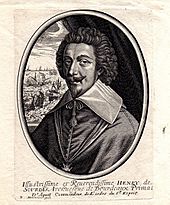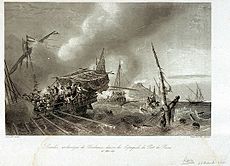Naval battle of Tarragona facts for kids
Quick facts for kids Battle of Tarragona |
|||||||
|---|---|---|---|---|---|---|---|
| Part of the Franco-Spanish War (1635) and the Reaper's War. | |||||||
|
|||||||
| Belligerents | |||||||
| Commanders and leaders | |||||||
| Strength | |||||||
| 19 sailing ships, 5 fireships, 11 galleys |
41 galleys, 7 brigantines |
||||||
| Casualties and losses | |||||||
| 50 killed | 12 galleys and 2,000 men | ||||||
The Battle of Tarragona was a big naval fight that happened from July 4 to 6, 1641. It was part of the Reapers' War, which was a conflict in Catalonia, Spain. At this time, the French and Catalan armies were trying to capture the city of Tarragona by surrounding it on land. The French navy, led by Henri d'Escoubleau de Sourdis, was blocking the city from the sea.
A Spanish fleet, made up mostly of galleys and led by the Duke of Fernandina, tried to break through this blockade. During the battle, some Spanish ships managed to get into the port of Tarragona. However, many Spanish galleys were later left behind by their crews who panicked and ran to the beaches. On the night of July 6, French ships, including some special "fireships," burned the abandoned Spanish galleys in the harbor.
Even though the Spanish managed to get some ships into Tarragona, the situation inside the city got worse because these ships brought more people to feed, not enough supplies. This made the King of Spain, Philip IV of Spain, send an even bigger fleet to help Tarragona later. This second fleet, much larger than the first, managed to defeat the French on August 20, 1641, and lifted the blockade. The French army on land then had to leave the siege of Tarragona.
Why the Battle Happened
After a big win for the Catalans and French at the Battle of Montjuïc in January 1641, they started to take back land from the Spanish. Philippe de La Mothe-Houdancourt, who was the new French leader in Catalonia, decided to attack Tarragona. This city was important and still controlled by the Spanish.
The French and Catalan armies started getting ready in March, gathering soldiers and supplies. Meanwhile, the main Spanish army moved closer to Tarragona. In April, the French and Catalan attack began. By May 4, La Mothe was in front of Tarragona with about 12,000 soldiers, and the siege began.

The French fleet, led by Admiral Henri d'Escoubleau de Sourdis, was there to help the army on land. Sourdis had about 30 ships and tried to block Tarragona from the sea. But because the city had a long beach, it was hard to completely block it. To make the blockade stronger, Sourdis captured some forts nearby in May and June.
The French blockade was quite effective. Even though some Spanish ships got through, the French captured or damaged others. The Spanish Duke of Fernandina, with 21 galleys, managed to capture a French ship called Lion d'Or but was then attacked by three French ships.
Sourdis's fleet had 15 large sailing ships called galleons, 4 smaller ships, 5 fireships, and 11 galleys. He made a mistake by letting Spanish fleets from Naples, Genoa, and Sicily join together. The French then found out that the Spanish were planning a big rescue attempt for Tarragona, both by land and by sea. The Spanish fleet, with 41 galleys and 7 smaller ships, appeared near Tarragona on July 3. Sourdis was sick, so he gave command to the Chevalier de Cangé, but he still helped direct the battle from his bed.
The Battle Begins
The Spanish galleys formed three groups to try and get around the French ships. Twenty-nine of them, led by Melchor de Borja, sailed past the French ships. One Spanish galley, the San Felipe, was captured by two French galleys. Two other Spanish galleys that fell behind were also captured.
Even though some Spanish ships were damaged, the Duke of Fernandina managed to reach the safety of the harbor with 11 galleys and 5 smaller ships carrying supplies. The French ships kept firing heavily, preventing the Spanish from escaping from behind the harbor wall.
French commanders like Vice Admiral de Montigny and Abraham Duquesne attacked the Spanish galleys. The Spanish crews panicked and started leaving their ships that were hiding behind the harbor wall. One Spanish galley was set on fire by a French fireship. About 4,500 Spanish and Genoese sailors tried to escape by swimming or using small boats. Around 300 of them drowned. There was a lot of confusion in the town as people tried to get supplies from the ships.
Several Spanish galleys were lost. The Duquesa and Patrona sank. The Santa Barbara, Patrona of Genoa, and Quatralba were badly damaged. The Santa Olalla got stuck near Salou and was destroyed by French soldiers on horseback. The French captured 450 prisoners and 3 Spanish flags. A Spanish officer named Captain Leonardo de Moles, known for his cruelty, was killed.
During the night, French fireships were filled with gunpowder. On July 6, escorted by 5 sailing ships led by Duquesne, they went to burn the remaining Spanish galleys. All these galleys were still abandoned, so it was easy for the French to set them on fire. In total, only about 50 Frenchmen were killed in the battle and the attack on the harbor. The Spanish were very angry about their defeat and even offered a reward for Sourdis's capture.
The Duke of Fernandina escaped with the galleys that had not managed to break the blockade. He claimed he had won the battle because he got some ships into Tarragona. Some Spanish historians agree, but others, like Catalan writer Víctor Balaguer, said that the 11 ships that entered the port were full of men, not supplies. This actually made the situation in the city worse and meant they needed another rescue attempt.
What Happened Next
Since the situation in Tarragona didn't get better after the first attempt to help, King Philip IV of Spain ordered a second, much larger fleet to be put together. He wanted this fleet to force Sourdis to stop his blockade and bring soldiers and supplies into the city. This new fleet was led by the Duke of Maqueda. He sailed from Cádiz on July 20 and gathered more ships along the way. The Duke of Fernandina joined him with his remaining galleys. This made the Spanish fleet very strong, with 35 sailing ships, 29 galleys, and many other vessels, totaling up to 108 ships.
Sourdis met this large Spanish fleet near Tarragona on August 18. The Spanish had many more ships, which allowed them to surround the French vessels and damage two of Sourdis's large ships. Sourdis knew he couldn't win, so he ordered his fleet to retreat.
The Spanish victory saved Tarragona, and the French commander La Mothe-Houdancourt had to stop the siege. He retreated, with the Spanish army chasing him. Cardinal Richelieu, a powerful French leader, removed Sourdis from his command and replaced him with his young nephew, Jean Armand de Maillé-Brézé. Even though Sourdis was successful in the first battle, his opponent Gianettino Doria felt that Sourdis was treated unfairly.
The Duke of Fernandina was also removed from his command, even though he had helped with the second victory. The Count-Duke of Olivares, a powerful Spanish minister, was unhappy because Fernandina didn't chase the French fleet, and he even put him in prison. In the months that followed, Maillé-Brézé proved to be a very good commander. He defeated the Spanish fleet in the Battle of Barcelona (1642). This victory allowed the French armies to capture important cities like Collioure and Perpignan.
See also
 In Spanish: Primera batalla de Tarragona para niños
In Spanish: Primera batalla de Tarragona para niños



